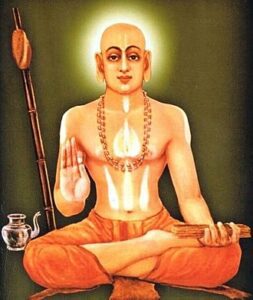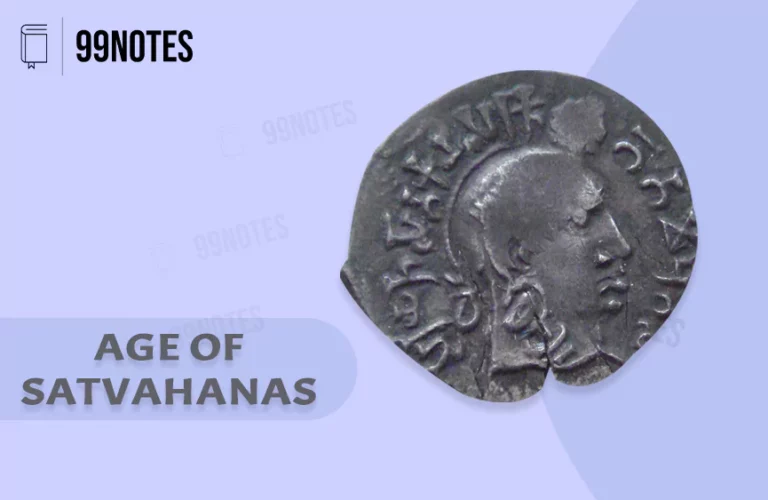Madhvacharya (CE 1199-1278 or CE 1238–1317)
Madhvacharya was a revered Hindu philosopher and theologian, made a lasting impact on Indian philosophy. He is best known for introducing the Dvaita (dualistic) school of Vedanta, which proposed a fundamental distinction between the individual soul (Atman) and the ultimate reality (Brahman).
Who was Madhvacharya?
- He was born in the year 1238 A.D. on the Vijayadashami day and was named Vasudeva during the NamaKarana ceremony.
- Madhvacharya was a third of the trinity of philosophers who influenced Indian thoughts after the ages of the Vedas and Puranas. He came after Sri Shankaracharya and Shri Ramanujacharya.
- He propounded the philosophy of Dwaita or Dualism.
- Madhvacharya is traditionally considered the third prominent incarnation of Vayu after Hanuman and Bhima.
- He was initiated into Sanyasa by Achyutapreksha, a great teacher belonging to the Advaita School of Philosophy.
- He was given the name Purnaprajna. It was also Achyutapreksha who gave him the title ‘Madhva’.
Early Life of Madhvacharya
Madhvacharya also known a Purna -Prajna and Ananda Tirtha, a significant figure of the Bhakti movement and a profound philosopher. He was born in a Brahmin family in a small village near Udupi, Karnataka, India. The exact date of his birth and life span is not confirmed but historian has controvercy between two time Periods of his life – 1199-1278 & 1238-1317. His birth name was Vasudeva, and his early life was deeply inclined towards spirituality and Vedic text. Madhvacharya is believed to have been a gifted child, who mastered the Vedas and other sacred texts effortlessly.

Philosophy of Madhvacharya
Sri Madhvacharya’s philosophical journey began at a young age of 16, he was initiated into sannyasa (monastic life), adopting the name Madhvacharya. After that he started a search of knowledge, studying the Vedas, Upanishads, Puranas, and other Hindu Scriptures.
Establishment of Dvaita Vedanta
Madhvacharya is famous for founding the Dvaita (dualistic) school of Vedanta philosophy. His philosophy represents a notable departure from the dominant monistic interpretation of Vedanta, particularly Adi Shankara’s Advaita Vedanta.
Madhvacharya’s Dvaita Vedanta philosophy proposes a rigorous duality between the particular soul (jiva) and the ultimate reality or God (Brahman). He postulated that both God and individual souls are eternally separate entities and that the physical universe is not a mirage but an actual existence.
Foundational Principal of Dvaita Vedanta Philosophy
Madhvacharya during his entire life spread his thoughts and teaching for well- being of individual. Important and key teachings of Madhvacharya philosophy:
- Pancha Bheda: Madhvacharya proposed five fundamental differences in realitly known as Panch Bheda. His Dvaita Vedanta is characterized by five fundamental distinctions:
- Between God and individual souls
- Between God and matter
- Among individual souls
- Between matter and individual souls
- Among various types of matter
- Eternal Reality of the World: Contrary to Advaita’s maya (illusion) concept, he believed in the real and distinct existence of the physical world.
- Hierarchy of Souls: Madhvacharya introduced the idea that souls have different intrinsic natures, leading to a hierarchical system.
- Dualism: His philosophy contrasts sharply with the non-dualistic (Advaita) Vedanta of Adi Shankaracharya, arguing that God, individual souls, and the world are eternally distinct entities.
Madhvacharya Books and Major works
Madhvacharya extensively traveled to many parts of India to disseminate his interpretation and teachings from the other two prevailing philosophies of Vedanta.
1. Advaita Siddhi
- One of Madhvacharya’s seminal works, Advaita Siddhi, is a comprehensive treatise on the Advaita school of Vedanta.
- In this work, he formulated incisive arguments and logical refutations against the Advaita philosophy, asserting the supremacy of his own Dvaita philosophy.
- The Advaita Siddhi showcases Madhavacharya’s deep understanding of the complexities of Indian philosophy and his ability to articulate his ideas with precision.
| He has authored 37 books in Sanskrit and his most famous book is Anuvyakhyana. |
2. Sarvadarshana Sangraha
- Another significant work by Madhavacharya is the Sarvadarshana Sangraha, a compendium of different philosophies prevalent in ancient India.
- In this text, he provided concise summaries of nearly 16 Indian philosophical systems, including Nyaya, Vaisheshika, Buddhism, and Jainism.
- The Sarvadarshana Sangraha serves as a valuable resource for scholars and students interested in exploring Indian philosophical thought.
3. Mahabharata Tatparya Nirnaya
- In his Mahabharata Tatparya Nirnaya, Madhavacharya undertook an extensive analysis of the epic Mahabharata.
This work explores the underlying philosophical and moral teachings of the epic, providing invaluable insights into its deeper meaning.
Other works include:
- Commentaries on the Prasthanatrayi: Including the Brahma Sutra Bhashya, Upanishad Bhashyas, and Bhagavad Gita Bhashya
- Madhvacharya Books:
1. Anuvyakhyana: A philosophical supplement to his Brahma Sutra Bhashya
2. Madhva Vijaya: A hagiography detailing his life and teaching
3. Tattvavada: Outlining the Principles of Dvaita Philosophy
- Devotional Texts: He composed several works extolling the virtues of Lord Vishnu. He also advocated for the worship of Lord Vishnu as the supreme deity.
Establishment of Udupi Krishna Temple
Madhvacharya is credited to the establishment of the Krishna Temple in Udupi, Karnataka. He is said to have discovered the idol of Lord Krishna in a block of Gopichandan clay and placed it in the Udupi Krishna temple. This Temple later become a significant center and hub for the propagation of his teachings.
Madhvacharya’s teaching significantly influenced Hinduism, particularly with the Vaishnavism Sector. He established eight Mathas (monastic orders) in Udupi to promote and preserve his Dvaita philosophy, which continue to be significant centers of religious learning.
End of his Life
It is said that Madhvacharya had a long life in which he only engaged himself with teaching and preaching his philosophy. The specific circumstances of his death remain unknown. Believers claim that he disappeared when teaching his students, which resulted in him being regarded as a god incarnation. According to some religious documents Madhvacharya left to Badrinath in 1278/1317 C.E. at the age of 79.
Conclusion
Madhvacharya, a visionary social and theological reformer, proclaimed that the path to salvation is accessible to all individuals, irrespective of their birth status. His teachings garnered a substantial following, revitalizing the Bhagavata or Bhakti traditions in Karnataka and inspiring a multitude of disciples.




